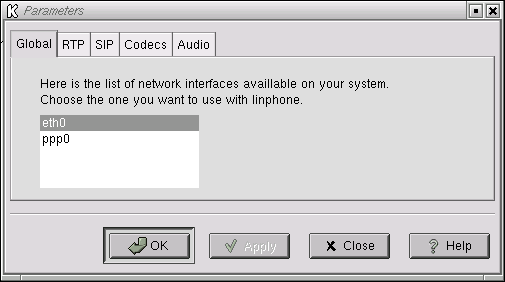 FRANCAIS FRANCAIS
|
NEWS:
All information here concerning linphone is outdated. The new web site of linphone is now http://www.linphone.org.
version 0.4.1 - Mon August 27 2001:
- Add address book.
- Add ring-back: the caller can now hear when it rings at the callee.
- Integration with new libosip-0.6.1 improves interroperability with some other SIP compatible webphones.
version 0.4.0
- The SIP fonctionnality is now based on the osip stack (see http://osip.atosc.org), for better compliance with
SIP RFC. Linphone-0.4.0 has been tested in front of some other (proprietary) sip-phones, and it worked !.
- New codec selection box, with automatic setup according to the network connection.
- G711 codecs added.
- Fix bug with icon unable to resize itself.
Important: linphone-0.4.0 is incompatible with linphone-0.3.0. This means you cannot call a linphone-0.3.0 with a linphone-0.4.0 and vice versa.
version 0.3.0:
- Linphone can run as a gnome applet, and the main window appears when you receive calls or when you click on the applet..
- For non gnome users, it is also possible to make linphone running as a daemon, that spawns its graphical interface when a call arrives.
- Linphone now comes with a test program called sipomatic: for users that don't have friends to call after downloading linphone and would
like to know if linphone works on their system.
See the user manual for explanations of how to make this test.
How to use it ?
Linphone uses the SIP protocol to establish the connection. To contact somebody you must give a SIP URL. It
is something like toto@machine.com, where toto is a linux user that runs linphone, and machine.com is the name
of a host on a network. If you do not have a name you can specify simply an IP address in dot notation (as 192.0.0.1)..
For more details, read the user manual in the help menu of Linphone.
Click here to download Linphone.
Here are the features of Linphone:
-
Gnome graphical interface
-
Work as cellular phone (two buttons to call, answer and hangup).
On the background:
Note for developpers: you are welcomed to reuse the two importants libraries of linphone that provide SIP
and RTP. You can make them evoluate as you want, but I would be glad if you would work together with me,
if possible.
SIP and RTP RFCs can be found at http://www.ietf.org and are open protocols.
Here are the main things of the todo list:
-
Allow linphone to work behind firewalls.
-
Add video support.
Compatibility
Linphone is mostly sip compliant. It seems to work successfully with these implementations:
- Hearme softphone (for windows)
- Pingtel phones (with DNS enabled and VLAN QOS support disabled).
Linphone may work also with other sip phones, but this has not been tested yet. So if you want
to complete the list by testing, contact me.
Linphone uses the SIP protocol to establish calls, for that reason it cannot work with H323 phones, because SIP and H323 are
different and opposite protocols. H323 phones are Netmeeting (for windows), Gnome-meeting (Unix), OpenPhone...
Note that Microsoft Netmeeting will move from H323 to SIP for future generations of Windows XP. It appears everyday clearer that the open and simple SIP protocol is much better than the closed and obscure H323.
Here are a few screenshots:


|




